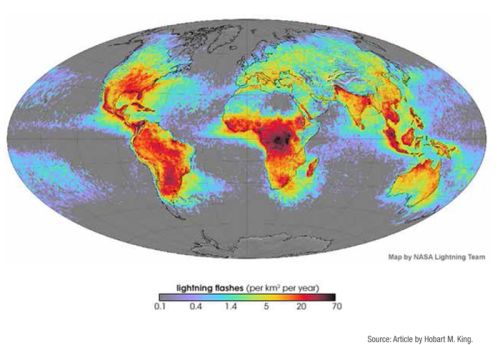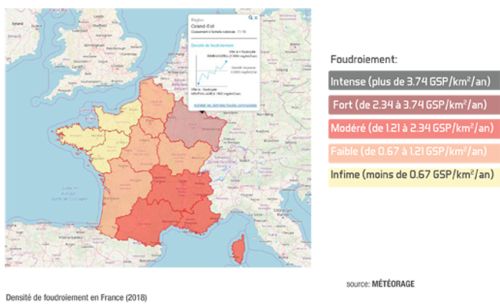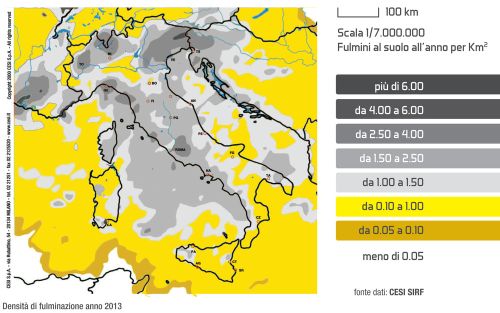LIGHTNING GROUND FLASH DENSITY Print

NASA has satellites orbiting the Earth with sensors designed to detect lightning and collect data, which is transmitted to Earth, plotted geographically and used to construct a geographic record of lightning activity over time. The map above shows the average yearly counts of lightning per square kilometer based on data collected by NASA's Lightning Imaging Sensor on the Tropical Rainfall Measuring Mission satellite between 1995 and 2002. Places where less than one lightning occurred (on average) each year are gray or light purple; places with the largest number of lightning flash are deep red, grading to black.
Globally, there are about 40 to 50 lightning every second, or nearly 1.4 billion of lightning per year. These electrical discharges are powerful and deadly. Each year, lightning not only kill people and wildlife but are also responsible for billions of dollars in damage to buildings, communication systems, power lines, electrical equipment and billions of dollars per year in flight rerouting and delays. Thus, maps showing the distribution of lightning across the Earth – which is far from uniform - are important for economic, environmental and safety reasons. The ideal conditions for appearance lightning and associated thunderstorms occur where warm, moist air rises and mixes with cold air above: the heated land surface warms the air above it, and that warm air rises to encounter cold air aloft. The interaction between air masses of different temperature stimulates thunderstorms and lightning. These conditions occur almost daily in many parts of the Earth, but only rarely in other areas of it. Moreover, much more lightning occurs over land than over the ocean because daily sunshine heats the land surface faster than the ocean. More lightning occurs near the equator than at the poles because not only the latter’s frozen surfaces are not effectively warmed by the sun to produce convection but also there is very little moisture in polar air.
Density of lightning flashes to the ground NG
The ground flash density NG is the number of lightning flashes per km2 per year. These values are provided by recording of all the flashes detected by the corrresponding lightning localization system (LLS) that covers the territory. The detection data registered by the LLS must be collected and processed, in order to calculate the annual number of dangerous events Nx according to EN 62305-2. It is sufficient to provide the geographical coordinates (latitude/longitude) to retrieve the corresponding value of NG. The ground flash density values are drawn from National database where available. Where no such database is available, the standard IEC 62858 Ed.2 (2019-10) defines to get the NG to multiply the NT (Flash NASA Data) by 0,25.

 Deutsch
Deutsch
 Français
Français
 Italiano
Italiano


